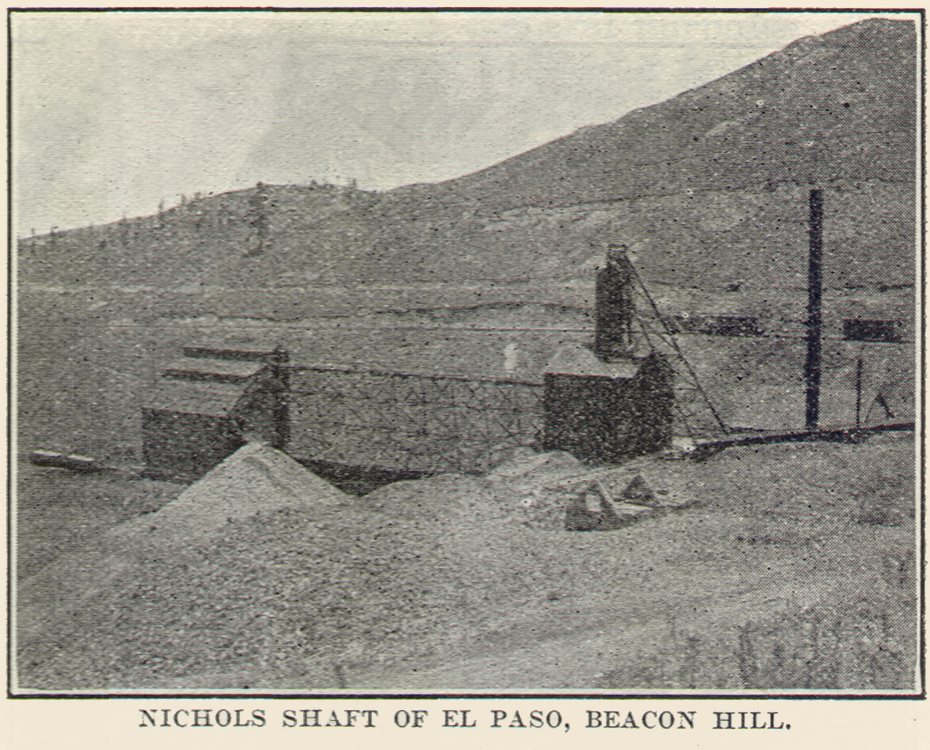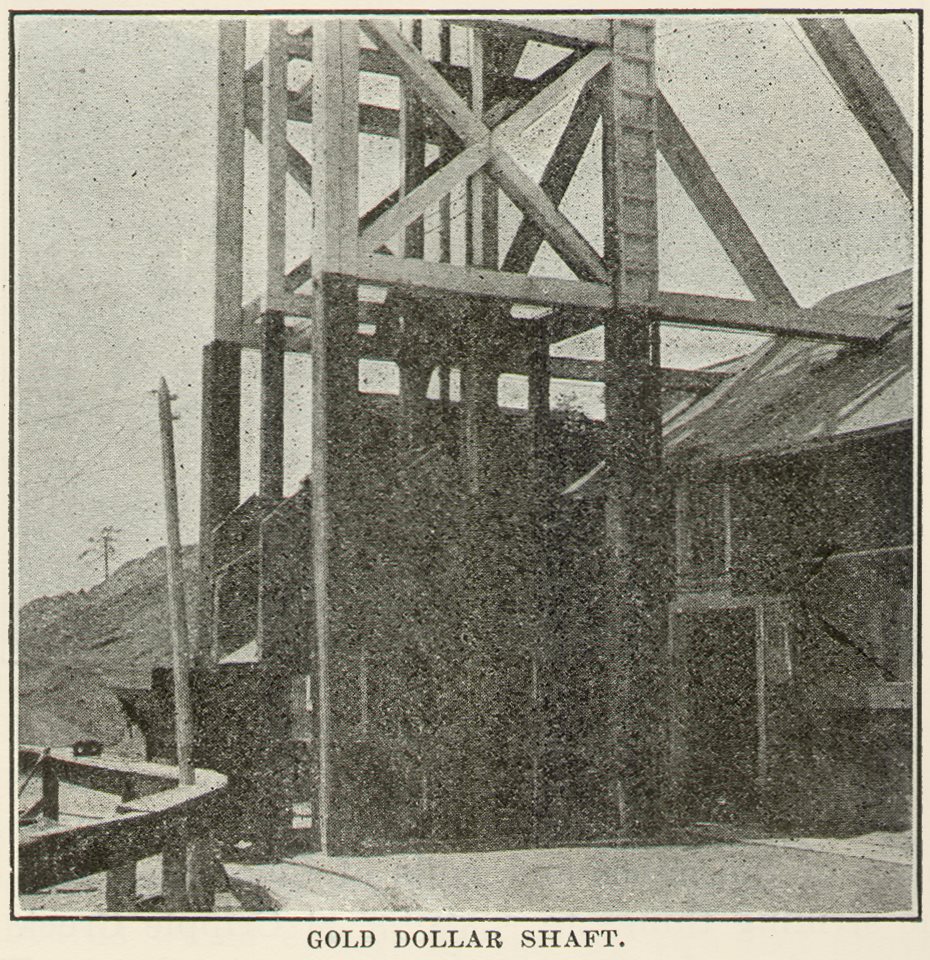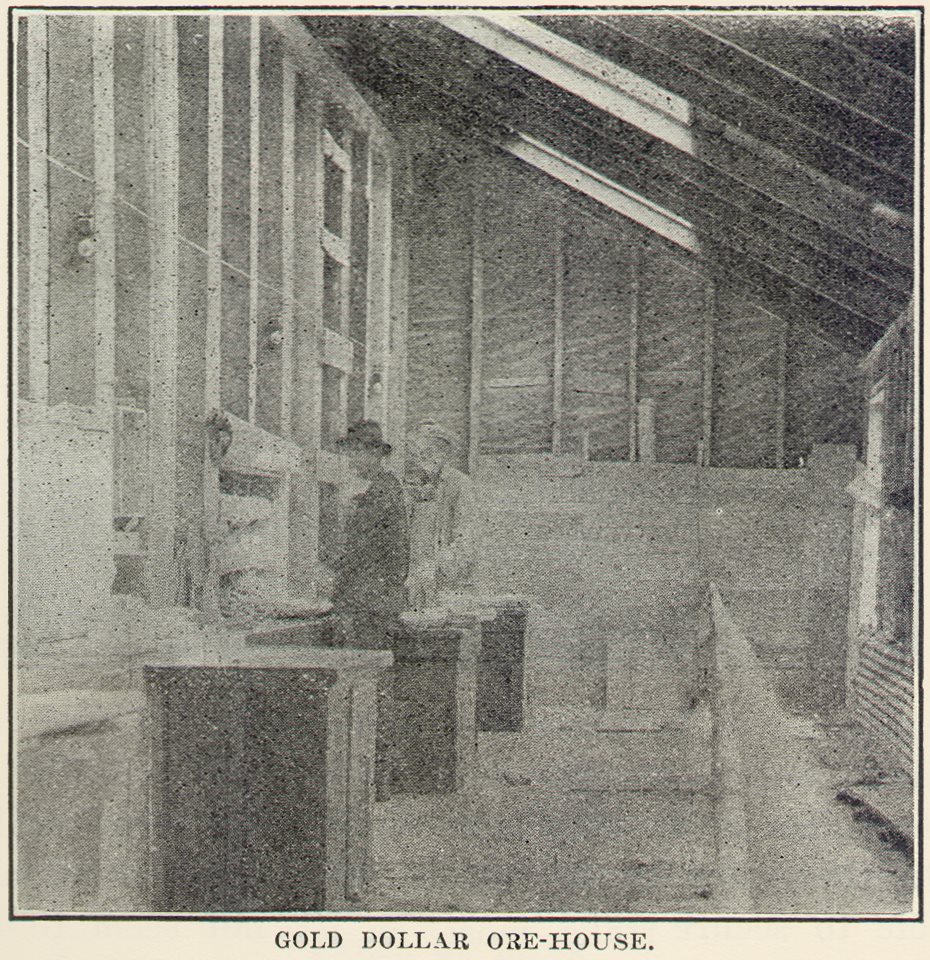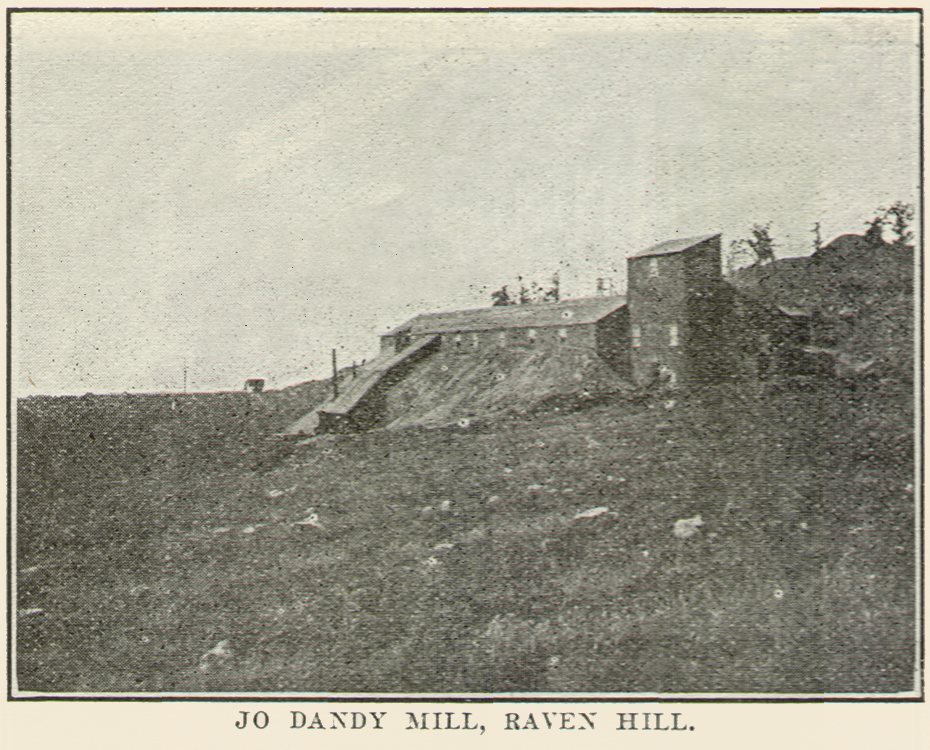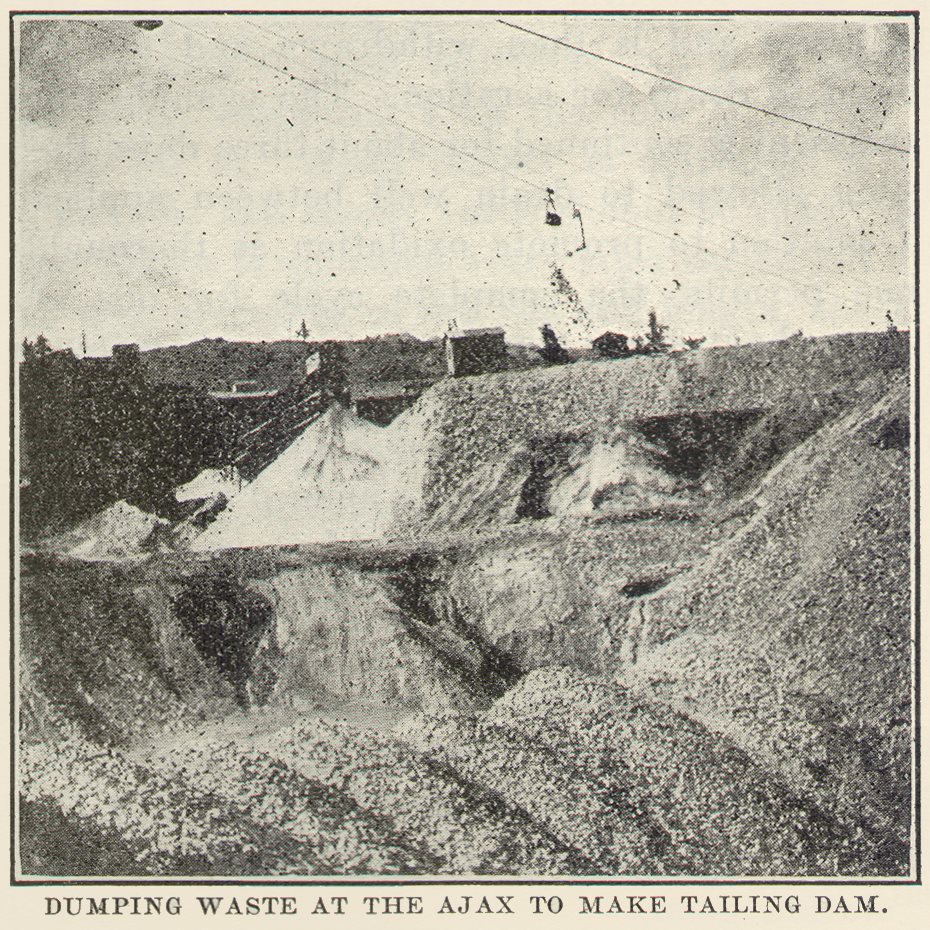-> My Collection; PDF File.
August 23, 1913 (page 297-300)
Two gentlemen, both of whom have been successful in the mining or allied businesses, have expressed to me in strikingly similar language an important point in their success. Several years ago a prominent mining engineer, a graduate of the Colorado School of Mines, said: "As I want to make money, I associate with people who have money."
Only a few days ago a successful lessee at Cripple Creek said: "I want to make a success of leasing or mining, therefore I stay where the good mines are, and that is why I am at Cripple Creek, for Cripple Creek is where the live ones are."
The mines of Cripple Creek are producing gold at the rate of about one and one-fifth million dollars a month, and still the people are complaining of things being quiet!
The present large production is due in great part to the development of the leasing system of operating the properties, and also in large part to the development of the means of treating low-grade ores. Both of these factors are being still further developed. A large number of miners are wandering about the properties where ground is offered for lease, poking into old workings in search for promising ground. Most of the men who are leasing are continually on the lookout for further lease opportunities.
Prospecting by Lessees
To illustrate this, I visited one old mine with two people who have a lease on it, to examine the property for a friend who was considering purchasing an interest in the lease. Two other miners were found in this mine, one of whom was prospecting an adjoining claim through this shaft; the other was simply poking about to see what he could find of interest with a view to a possible lease. I also found that a friend who accompanied him to assist in the examination, a man who is now leasing at Cripple Creek and has had long experience there, was well posted on this property before I visited it, his incentive being to know of any good opportunities for leasing. And this mine was practically without equipment and would need considerable expenditure for timbering and cleaning to get in working order.
Lease Contracts
Most of the leasing is on the basis of a flat rate royalty of about 25%; and in many cases whole properties are let on about this basis to one or more sets of lessees. Other mines lease on a system of graded royalties, the royalties increasing with higher grade of ore, and some even increasing the rate if production exceeds a fixed sum per month. Lessees working on such a basis are not able to do any dead work, and can simply strip out what ore they can secure most easily without regard to developing more. This is said to be particularly true of the Stratton's Independence lease work.
In certain cases larger operators take a lease on the entire mine and sub-lease in blocks to smaller operators. In these cases it is usual to provide the sub-lessee with all equipment and supplies, such as tools, air-drills, compressed air, steel, powder, and the like, so that the sub-lessee risks only his time. The basis of settlement in such leases is first to take out of the returns from shipments the company royalty of 20 to 25%, then the original lessee and sub-lessee 'split the check'; that is, divide equally the remainder. This arrangement seems to work well. The miner can break so much ground and handle it with machine drills and good equipment that he can still make good wages in many places on this basis. Many prefer to do this rather than pay a smaller royalty and work with hand steel.
Some of the larger companies have recently adopted this plan of 'staking the miner.' One company has opened to this scheme of leasing what is considered to be worked-out ground in its mine, and a number of sets of lessees are doing well for themselves.
On these terms, which are more favorable than in the case of sub-leasing because the returns are not first diminished by deduction of any company royalty before the equal division between miner and company, the lessees have been able to do considerable prospecting and have opened some good shoots of ore. In most cases of leasing here the terms are not made sufficiently liberal to allow the ordinary lessee to undertake any considerable development work. So many miners are wanting to lease that the royalties are held high, and few, if any, concessions are offered to secure the performance of development work on a large scale.
On the other hand, leasing companies which are able to secure outside capital do not seem to be afraid to undertake more or less dead work in promising ground.
Economy of Lease System
There are so many ways in which lessees' expenses are lower than company costs in the same work that these men working on their own account can often make a place pay where it could not be made to pay for company work. Miners will often work harder for a lessee than for a company, and also will work with less equipment than would be demanded on company work. The companies are reimbursed for the large winnings of the fortunate lessee by the fact that other lessees may be making money for the company when they are not making any for themselves. Many of the companies are making money on the leasing basis which were losing money to work the mine on company account.
Freight and treatment rates are now so much lower than formerly that lessees are able to ship ore of as low grade as $10 per ton and realize a small profit, although, of course, this kind of material will not stand a heavy mining expense. This assists materially in prospecting, the rate on ore of up to $10 value being $4 for freight and treatment. When leasing on a dump, it is usually considered that men can make wages if they get rock of $7 grade to ship, and anything above that is 'velvet.' It can easily be understood that with so many miners on the ground hunting for leases, there are not many mines open for lease which are idle if there is ore in sight.
It is often men who have worked in the mine for the company and who know of some promising stringer overlooked in company work or considered too small to follow who are most anxious to secure a lease.
Safety Measures
Before turning to the milling in the district, which is the other large factor, with leasing, in maintaining the great production, a few remarks may be made about some other points in mining. To a person used to seeing the many safeguards to men which have been adopted in many of the Eastern mines and industrial plants, it seems that a 'Safety First' campaign would not be amiss in many of the mines and mills of Colorado. One of the striking things to a visitor at Cripple Creek is the number of maimed men to be seen there. The dangers in the gold mines and mills are in general different from those to be overcome in coal-mining and steel works, but they are, according to statistics, productive of a greater number of fatalities in proportion to the number of men employed. It would seem, therefore, that even more stringent safety measures should be adopted than in the case of coal-mining. Some improvements along this line have been accomplished, but much more remains to be done.
Many of the improvements along this line are incidental to changes designed to lessen costs, etc. For instance, many of the mines have changed from the use of cages for hoisting to the use of a moderate-sized skip. Of course, the skips are used primarily to reduce the cost of getting ore and waste handled, but the safety feature of the change would seem to be one of no little importance also. The miners riding in a skip with sides three or four feet high are protected to a considerable extent from accidents in the shaft.
I know of at least several fatal accidents due to men falling when on a cage, or in some way moving enough to get caught in the shaft timbers, which accidents might have been prevented had a skip been in use in place of the cage with a platform which is not protected.
There are minor points of interest in the equipment of most of the properties, large and small. There is a marked tendency toward the application of little devices to save labor and make work more efficient for an equal effort. A good many lessees are compelled to start their operations at least using the old Armstrong, back-breaking hoist.
Almost every kind of hoisting rig can be seen at one mine or another from old to the most modern steam and electric hoists with steel head-frame as at a number of places, and occasionally with the hoist housed in a fine brick building as at the Gold Coin and the more recent Nichols shaft of the El Paso.
On several of the smaller steam-hoists using buckets, a device is employed, or several devices, so that the engineer can close the door over the shaft, dump the bucket into the receiving bin or car, then release the bucket and let it down again without leaving his seat at the engine.
At most places with bucket hoist this operation requires two trips from the engine to the shaft. This labor saving can be accomplished, as at one place, by ropes over pulleys to manipulate the door Over the shaft, and by a steel 'V' frame hung from an outrigger which can be pulled by another rope under the bucket so that a chain and ball under the bucket will catch in the point of the 'V', and on releasing the hoisting cable the 'V' frame catches and overturns the bucket, drawing it away from the shaft and over the receiving car as it catches.
Surface Tramming
Motor cars have been adopted at many of the mines for surface hauling.
Two views at the Gold Dollar mine are shown, where the equipment is good in certain respects. Surface tramming is done by electric cars using 3-phase, 550-volt motors. The three trolley wires are mounted in a channel built of boards which can be seen about two feet above the ground at the left of the track in the view. There is not much likelihood of anyone coming in contact with these wires accidentally, protected as they are in the deep channel by the overhanging boards.
At the hoist is an electric annunciator with a number for each level, connected in the same way as the call-bells in a hotel, so that the engineer, instead of having to listen to a signal given by a number of rings of a bell, merely has to look at the annunciator to see what number has been called. This must leave his attention more free for other signals, such as those telling him what he has in the skip each trip, whether it is waste, or, if ore, to what bin in the ore-house to send it. This annunciator is also a safety measure, for the number is in sight until released by the engineer himself.
At many other mines, calls for the cage are given by flashing an electric light, this flashing showing in a light at the landing of each level so that the cage-tender knows of any call for the skip as well as the engineer; and the call has to be answered by a return flash from the engineer. This system has the advantage over the annunciator that the call may be known at any level, and the person giving the signal is answered by the engineer, thus making it certain that his signal has been received.
In the view of the ore-house a bell can be seen above each sorting table. This is used to announce to the sorters into which bin ore is to be dumped at any time. Men working at other tables are in this way secured from interruption of their work by having to wait for the ore to be dumped after they hear the ore-car coming above. This view gives an idea of the interior of a modern Cripple Creek ore-house, with the men working at the sorting tables. Notice the excellent light obtained by windows in the roof as well as in the side walls, and also the ample radiator provided for heating in winter. The heating is an important item, both that the ore shall not freeze in the bins, and that the men's hands shall not get too cold from handling it to do efficient work.
Types of Mills
A large number of mills are now working in the district, and several other large companies are experimenting on different treatments and considering the installation of mills. Metallurgically, the operating mills fall into two groups. The mills of one group practice coarse crushing only, have simple equipment and low initial expense; while those of the other group represent a heavy initial installation cost and grind at least a part of the ore very fine.
Mills of the former type, such as the Wild Horse and Isabella (the Isabella not working just now) have been working for a long time in the district; while the latter type of treatment for the most part has been developed within the last three years.
The simpler type of mill is well represented by the Jo Dandy, of which a view is shown.
This plant is treating a large mine-dump on Raven hill, and is right at its source of supply of ore. The ore is shoveled and trammed by hand from the dump to the mill, where it is dumped over a grizzly into a 10 by 20-in. Blake crusher set to break to about 1½ inches. Two stands of 16 by 36-in. rolls take the product of the crusher. The product of the rolls is elevated to a hexagonal trommel screen 8 ft. long and set with 1 ft. inclination in the 8 ft. This screen is 3-mesh No. 12 wire and runs at 15 r.p.m. Oversize from this screen returns to the rolls again; and the undersize is delivered to a belt-conveyor which transfers the material to the leaching vats. There are four of these leaching vats, 5 ft. deep and 30 ft. in diameter, and of about 125-ton capacity, in use. In charging the material into the vats, considerable care must be exercised to avoid channeling later on account of the large range in size of the material treated. Solution is first applied from below for the same reason. But one strength of solution is used, from 1½ to 2 Ib. per ton. The first solution stands on the ore for 12 hours and is then withdrawn and the ore allowed to drain for aeration. The cyanide leaching treatment is continued for about three days, the vats being allowed to drain well between applications of solution to promote oxidation as thoroughly as time permits, the complete cycle for one charge being about seven days. Just enough water wash is used at the last to keep up the solution in the mill; and then the exhausted ore is shoveled out of the vat by contract and trammed in hand-pushed cars to the dump. This would seem to be one of few mills in the district not troubled by a lack of convenient dumping room.
The pregnant solutions are precipitated by zinc shavings in the usual 6-compartment boxes, the barren solution going to the storage vats. The cyanide solutions are made up to strength by adding the salt at the head of the zinc-boxes to keep the precipitation good.
Thomas Kavanaugh, who is operating both this and the Homestake plants, says the rock is a sylvanite ore containing considerable arsenic and manganese and is extremely refractory, with not over 10% of free gold. He says he is securing about an 85% extraction and that the ore runs about $2 grade, which is an extremely good result on such coarse refractory material. Mr. Kavanaugh has but recently started up the Homestake plant. This and the Wild Horse and Dante mills are following nearly the same practice; but they are working on oxidized material, whereas the Jo Dandy dump ore is said to be refractory.
Position of Gold Minerals
The explanation of the development of this simple inexpensive treatment lies in the position of gold minerals on the seams in the rock, along which seams the rock almost invariably breaks in crushing. If it were not for this distribution of the gold, fine grinding of the material would be required, for the rock itself is usually extremely dense. It may even be said that if it were not for this fact of the seams containing metal and being extractable largely on crushing, it is probable that no such development as the present could ever have occurred at Cripple Creek.
The ore content, considering the ore-shoots as a whole, are usually too low to be commercially valuable without screening and sorting and saving for the most part the fine only, and discarding the coarse material. Of material which is hoisted from the ore-shoots themselves, not much more than 20 to 40% on the average is saved as ore. As the waste from this is in addition to the large amount of waste raised from ordinary development work, the size of the Cripple Creek waste dumps is enormous. But it is far cheaper to dispose of this large mass of low-grade coarse rock by leaving it on the surface at the mine than to handle it further as would be necessary if the mineral content were uniformly distributed throughout the rock, and all the rock had to be crushed and milled.
Modern Mills
The later more elaborate mills can be considered to be a development of the simpler practice above outlined. Without going into the detail of any one mill, a few general points of the treatment may be mentioned. The practice has been adopted at two places of breaking the rock to walnut size, then screening through a finer screen of from 4 to 8 mesh, and saving only the fine material for further treatment. When the coarse material is muddy, it is washed to recover the fine material.
This practice saves perhaps 20 to 30% of the fine material out of ore which may assay perhaps $3 before breaking, the portion saved being of some $8 or $10 value. The erection of a crushing and screening unit to apply this treatment preliminary to shipment is being considered by other mine managers, and careful experiments are being made to determine just what screen and crushing sizes are best and how much washing should be applied.
The treatment at one plant includes grinding of the above material in cyanide solution in roller mills, then concentrating on Wilfley tables. The tailing from these tables after dewatering is discarded, as it is of such low grade as to make the leaching cost about as much as it would return.
The concentrate, after being cleaned on a second set of tables, is shipped to the smelter; and the middling from this set of tables is reground in a tube-mill and cyanided as slime. The slime overflow from the sand tailing is also treated by agitation. Gold-bearing solution is precipitated with zinc dust. The details at the large new mills vary greatly; but the above may be considered to be an outline of the treatment adopted.
Most of the mills are facing difficulties in disposing of their tailing. The finely ground material discharged while wet tends to spread over the ground and not to stack well. One of the mills at present is storing the tailing in a deep gulch behind a dam of waste rock from the mine. The dam is being built by means of an aerial tramway dropping rock where needed for the purpose.
From the present situation in the district, it seems probable that both leasing and the milling of low-grade ores in mills situated near the mines are to be greatly extended in the next few years.
